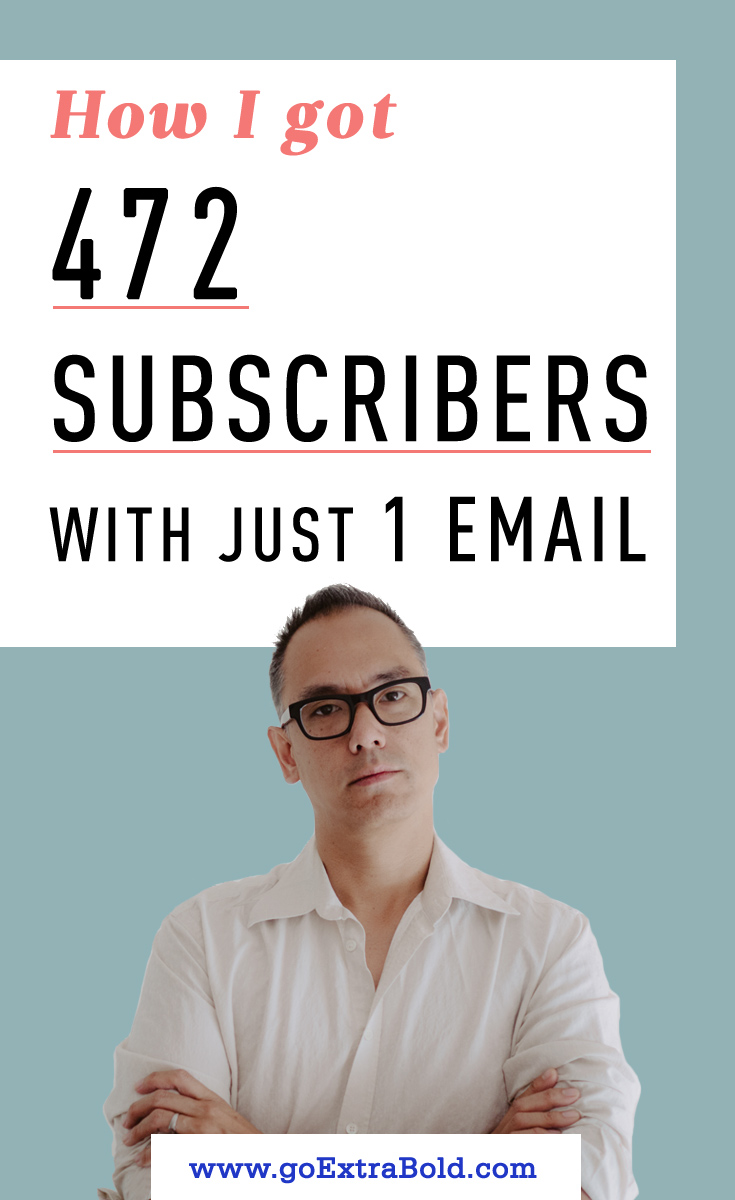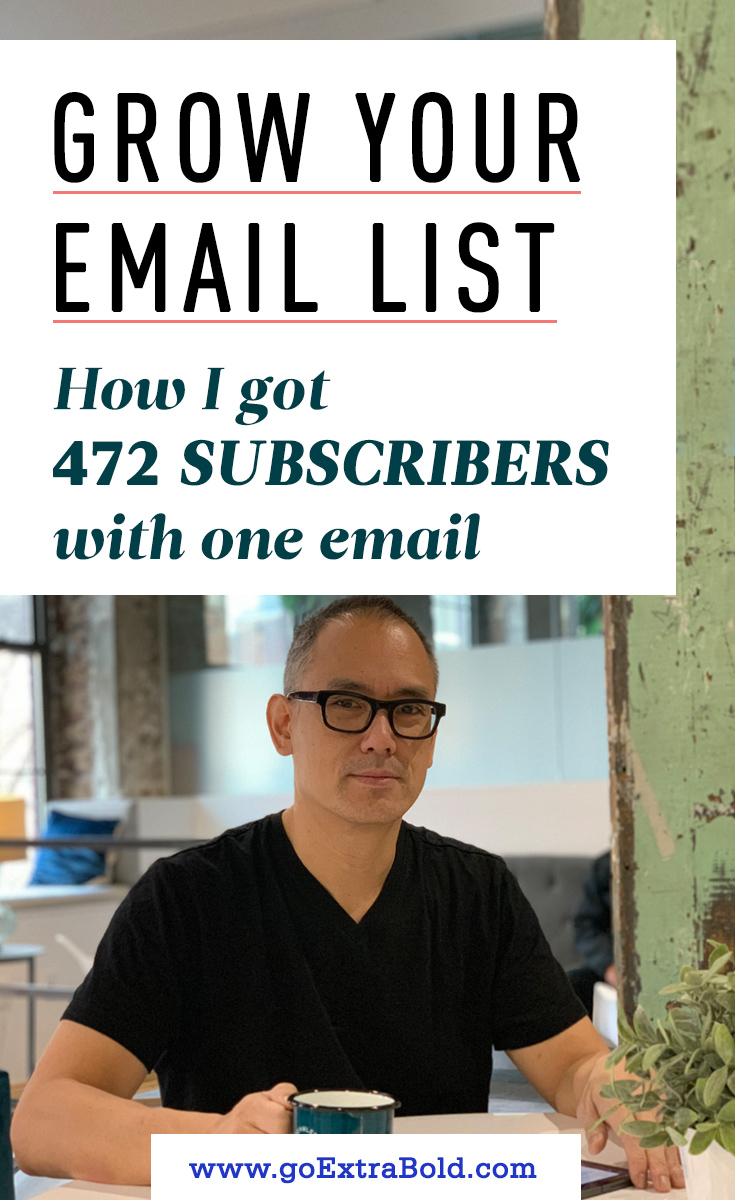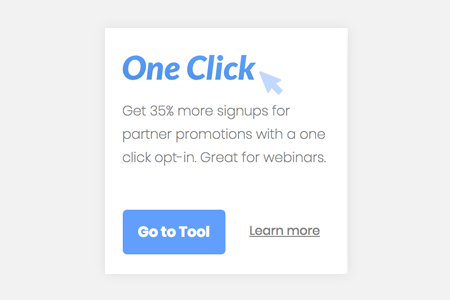You’ve probably heard them all before…
Dozens and dozens of ways to get to the 1,000 subscriber mark…
The list never stops: Create great content. Tell all your friends. Guest post. Podcast. Share on social media. Comment on posts. Run webinars. SEO. Pinterest. The strategies go on and on, but OMG. We’re talking epic levels of overwhelm and no clear guidance.
And no matter what you do, the growth still feels glacial as hell, not to mention that every time you try something new, it’s a whole new can-o-whoopass being unleashed on you.
There’s a better way.
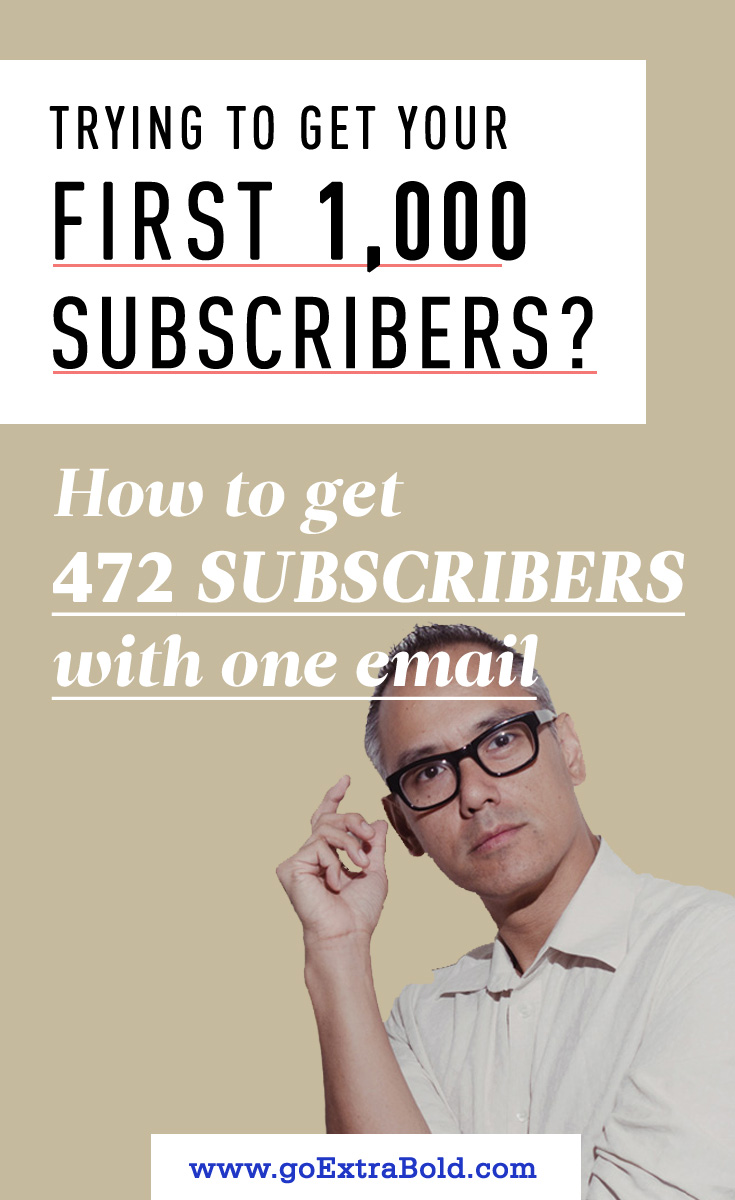
The truth is, it all comes down to one big, fat, hairy problem: no one knows who you are.
You shoot a newsletter out and you get crickets.
You post and people treat you like you’re nobody.
And partners? It’s like begging for business.
And what that means is no matter how good your product, even if you’re a dead-to-rights, true-blue expert, there’s still no way to sell what you’ve got.
So here’s the a strategy that works whether you’re big or small, and, most importantly, even when no one knows your name.
Read on, and I’ll show you’ll learn the exact steps I used to get 472 subscribers in a single email by working with Bryan Harris of Growth Tools and Videofruit fame.
And to be clear, this isn’t hocus pocus stuff.
There’s work involved.
But a whole lot less than most of the “instant” strategies out there.
And even if you feel like the unpopular kid getting picked for teams in high school, none of that is going to matter in just a short bit.
You’ll get a steady and predictable way to grow your list, so you won’t have to let your time bleed out watching webinar after webinar for 10 minutes of red meat just to learn a sliver of a newer and shinier trick.
And it just plain works…
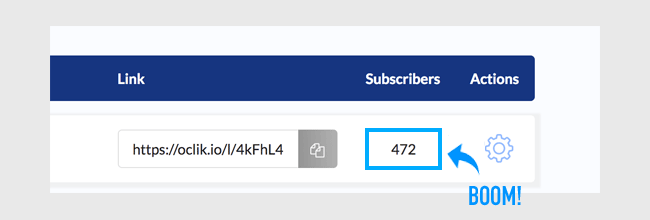
Here’s What No One Really Explains
You’d be hard pressed to toss a rock at a gaggle of sponsored-ads without bowling over a dozen “secrets” to grow your list instantly.
And for good reason.
Whether you’re selling products, coaching, or building your empire online, the list is life.
But here’s the thing…
Yes, they all work.
But you’re still going to have to pick your poison. And if there’s anything that really separates the people who make it from the people who don’t, it’s knowing how to pick the right poison and stick with it.
Here are the things you need to think about.
Camp 1: Twofer One
Let’s start with the “Get 2 bucks for every 1 you put in” crew. The whole idea here is that you pay for ads, but that the cost doesn’t matter, because the value each subscriber brings on average is going to be worth more than the cost to get them.
And it sounds sexy AF.
It’s like getting your hands on a neverending money machine. And when it works, it feels like it, too.
But this approach is where all the funnel talk comes in to play, and that means complexity. As in lots of it. Carts, upsells, retargeting, tripwires, landing pages, segmenting, plugins, split tests, content upgrades, upsells, and so it goes.
Not to mention the bulletproof copywriting skillz you’re going to need to make it all sing.
And even though fast and amazing results are possible, it’s easy to blow through $1-4 per subscriber. And that’s when you do things well. Never mind what happens when you do things wrong. $19.29 per subscriber, anyone? Because, yeah, that type of thing happens.
So you’ve got two big downsides. Potential cost. And a steep learning curve.
So does that mean I’m saying not to do it? No. In fact, I’m not saying not to so any of these. Like a I said. They all work. But what I am saying is not to bet the farm on it straight out of the gates.
Camp 2. Passive-Income Alley
Don’t get me wrong. Passive income is great. But like all holy grails, these approaches are fraught with their own special peril that go with the road to promise.
Typically passive-income strategies come down to either SEO or Pinterest, though there are different flavors. But whatever the specifics, it’s always about generating recurring traffic that builds on itself. After all, if you get traffic, you build your list, right? So it makes sense.
The setback here is the time. Sure. Every course under the sun will tell you that you can get results in no time at all. Weeks. Months.
What’s great is that you don’t have to invest a cent to start. What’s not is that you have to invest a shit-ton of time to work on small, obscure details and learning to use a plethora of plug-ins that are going to make you feel like you might as well have gotten the degree in technology you never wanted.
Why? Because passive-income is a carrot on a stick that ignores the reality that most people are really busy.That means they run out of steam, before they see the payoff. Not to mention, no matter how good the strategy, one size doesn’t fit all, and you’re going to still have to figure things out and do a lot of research and reading.
So, again, like funnels, it works.
But you don’t train for a marathon by getting ready for a sprint. Treat it like an investment in your long-term success.
Camp 3. The Partner Track
The last group of strategies is based on partnerships. After all, if you can partner with people who have more reach than you do, you can get free ride on their coattails. Which is all great, except it means the N word…
Networking.
And if you’re like most people, the idea of networking might just make your throat constrict as you break out in a cold sweat. After all, who wants to deal with the rejection and the special awkwardness that goes with making yourself vulnerable in front of a complete stranger?
But here’s what the goo-roo brigade doesn’t typically tell you…
A huge portion of all those list-building strategies really aren’t list-building strategies. They’re networking strategies disguised as list building strategies in sheep’s clothing.
For example, you wanna do a giveaway? Guess what. Whether you’ve got KingSumo and pipe dreams of big time virality or not, the odds are, you’ll need to find some influential people to share your giveaway to their audiences. Which means…networking.
How about webinars? If you don’t want to pay for ads, then partners are one of the best way to promote them. Networking again.
Guest blogging? Well, ‘nuff said on that. It’s someone else’s blog, after all. The same goes for podcasts.
And so it goes. At the heart of most “I got me a bajillion (followers or bucks or subscribers) in 14 days” strategies” is the fact that they typically only worked because of that person’s network.
So Which of the 3 Strategies is
Right to Build Your List?
So what’s the best approach?
If you’re just getting started and you’re like most people, focus on building partnerships.
Here’s why…
Ads get expensive, fast. There’s the cost of the ads. There are the services you’ll need to support them and to monetize them. Plus, they fatigue, so you have to keep reworking them. And they’re not easy to write well, if you’re not used to it.
And strategies like SEO and Pinterest usually aren’t explosive. So even though they’re worth doing, they won’t set you up.
And that leaves us with partnerships.
Yes, they take effort.
But what doesn’t?
The thing about partnership strategies is they put you in control, because they’re based on how much effort you put in. You can get more results or less. You can make things happen faster or slower.
And you don’t need any experience to get started.
Better yet, they scale as well as anything else. As you know more people, your social capital grows, and it gets easier and easier to know even more people with more influence and reach. It’s like compound interest.
What you invest now comes back tenfold later.
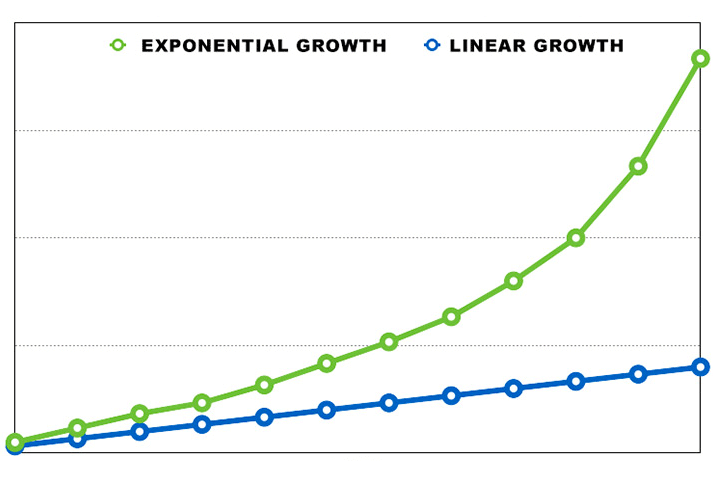
How to Do Lead Magnet Trades
To Build Your List Fast
What is a Lead Magnet Trade?
It’s super simple.
A lead magnet is a freebie like a guide or a cheatsheet that you give out to get people to subscribe to your list. The way a Lead Magnet Trade works is you promote someone else’s lead magnet to your audience and they promotes yours.
Why is it so powerful?
Three reasons…
First it scales.
Second, because you’re actually offering to help partners build their list, it’s a win for them.
And third, it’s a very small ask.
And this last point is way bigger than it sounds, because when you’re building partnerships at first, there are two very real barriers that can make potential partners run for the hills. But lead magnet trades avoid both of these pitfalls:
Barrier #1: It can take a lot of time
Maybe you ask someone to go grab a coffee. Maybe you ask to work on something together. Maybe you ask them to promote you. Whatever it is, it can be a big time suck for your partner, meaning that there’s a good chance they won’t want to do it unless they know they can get results.
But if you have no track record, then guess what? Right, there’s no way to prove they can get results.
Barrier #2: There’s risk
When you ask people to stump for you, they have to put their reputation on the line. Not to mention they might be using up the goodwill of their audience by pitching you. And no one wants to burn out their list.
When someone shares your lead magnet, it takes almost no work at all. You just send out an email. Not to mention they’re giving their audience a free resource, so it doesn’t expend any good will.
And because they know what lead magnet they’re promoting, there’s no risk of embarrassment, either. So you’ve got the perfect low-friction pitch to build your list and to get your foot in the door grow a new relationship that can lead to even more opportunities in the future.
Does it work?
Like I said at the start I did a trade with Bryan Harris to promote his tool, ListGoal (Get ListGoal and all of Bryan’s other tools by clicking here), and it got me 472 subscribers directly, plus over a hundred more indirectly, while he shared my Dark Arts of Subversion guide, where I show you how to make people do anything you want.
And, just so you know, I get zilch for promoting Bryan. Not even a T-shirt. But his tools are uh-mazing, and I’m spreading the love.
So let’s break things down.
GET THE DOWNLOAD: Sign up for my free influence course, and you’ll also get a link to my Dark Arts of Subversion guide in your inbox. (All I ask is that you share the guide with others.)
The Blow-by-Blow Breakdown
STEP 1: FIND PARTNERS
This is easily the most time-intensive step.
And, yes, it takes some real legwork, but it doesn’t have to be a big time-suck. If you devote an afternoon to it, you’ll have done more than enough research to last you months.
But there are some sticking points, so let’s look at the right way to find people.
The Two Big Problems…
So, the thing to know here is that even though there are way more businesses who are just building their list than there are businesses with mega-lists, it’s also way harder to find the less-established people who are hungry to build their list.
Makes sense.
People with mega-lists have mega-reach, so they’re easy to find.
But, of course, if you just up and email Marie Forleo or Ramit Sethi out of the blue, guess what’s going to happen?
Right. Nothing.

But first, the other thing to know is that you have to find people with the same target audience, who aren’t competing with you.
For example, I teach entrepreneurs, coaches, and consultants to get clients by creating addictive content.
While it’s fully possible to trade with other content strategists and copywriters, because we have similar products and services it’s a less natural match.
Sure, there’s plenty of business to go around, and I’ve done very successful trades with people who are technically my competitors, but the hurdle here is that getting someone who sees you as a competitor to work with you takes a little more convincing.
It’s still fully doable. But it’s not as easy.
So what works even better are complimentary businesses.
For me, that might be a speaking coach, as an example. Their audience would be the same as mine, but because they’re offering a different solution, we’re not direct competitors, and my lead magnets will adds more value to their audience.
Either way, once you know who you’re looking to partner with, here’s how you find those hungrier people.
1. People You Know
I’m amazed at how many people never use their own network. That’s what community is for. People want to help you, so ask around. It may not lead to anything, but if you dig hard enough, there’s a good chance it will open a door somewhere.
2. Facebook Groups
This is one of the best ways to find people who are just getting started. You can look at free groups, as well as groups for courses you belong to. Just see who else belongs to those groups, and look up their profiles. It takes some snooping, but it works.
So get started by finding a bunch of FB groups targeting businesses similar to yours, then look up everyone in there. Once you join some groups, FB will start recommending more, so it will help you do your research. You can also use LinkedIn groups in a similar fashion.
3. Testimonials
You know how everyone and their sister sells a course? Well, almost all of them have testimonials. And the odds are most of the people giving the testimonials aren’t going to be that established, so they’re going to be much more open to trades.
So find a bunch of people offering courses that help businesses like yours, then read over all the testimonials and hunt down the people who look like they could be good partners down the road.
4. Podcasts
There’s a huge base of podcasts out there, and not all of them feature mega-stars. Find some of the smaller podcasts, and scroll through everyone they interview.
5. Google
Once you find someone you’d like to partner with, you can search their name, and see what podcasts they appear in and where they’ve done guest posts. Then you can go to those sites, and find who else has been featured, since they’ll likely be people with a similar level of influence.
6. Summit Participants
Online summits regularly feature dozens of presenters. Since they’re presenting, they’ll be a little higher up on the food chain, but a lot of the time, not by that much. Many of the participants get very little for it, and they’re simply trading time for exposure, so you know that they’ll be looking for opportunities to build their list.
STEP 2: CONTACT THEM
There isn’t much to be said here. You simply reach out, and offer to do a trade and see what happens. Don’t overcomplicate this. Make it easy for them to reply to you without having to read too much or do too much.
And be sure to make a call-to-action at the end, so they take the next step.
But what do you do when you have no list at all?
Start by thinking about what you can offer in exchange other than exposure on your list. Do you have a large following on FB? Twitter? Instagram? Is there something else that would help them?
If there’s nothing you can come up with, if worst comes to worst, you can always utilize the power of a favor.
Start the relationship by asking your potential partner if they’d be willing to be featured on your blog.
There’s a god chance they’ll say yes. So after you’ve done that and given them some value, see if they’d be willing to help you out by sharing your lead magnet to their list.
STEP 3: TRADE LEAD MAGNETS
This step is simple. Just create an email featuring your new partner’s lead magnet, and have them do the same.
Easy peasy.
With that said, if you want to improve your results by a good 30% plus, here are two things you can do to finesse the process.
First, grease the wheels.
Remember, people tend to stall FOREVER.
Never underestimate how slow people can be. So send over clear cut instructions, and, better yet, write the exact email for them. They can always adjust it, but that’s going to remove the natural friction people will experience.
The second thing is you’ll want to use is another one of Bryan’s tools. This one is called One Click. See, normally the way it would go is like this:
Click Link in Email > Landing Page > Sign-Up
So what’ll happen is some people will click on the email link, but once they get to the landing page, they’ll bail, instead of signing up.
Yeah, makes no sense. But people are flakey like that.
One Click solves this.
When you sign up, you get a custom link that people can click in an email, and when they do, it automatically stores their name.
So now it goes like this:
Click Link in Email > Sign-Up
It’s like cutting out the payment to the middle man, and without a landing page in the middle, now you capture everyone’s name. It’s a neat trick.
STEP 4: SCALE IN ADVANCE
At this point, you’ve done your trade, you’ve grown your list, and everything is hunky dory.
Sort of.
But there are still a few ways to milk even more out of the experience…
1. Incentivize people to share
Yes, here’s one more tool from Bryan. This one is called GoViral (sign-up for free here), and I’ve saved the best for last, because this one is my absolute favorite, and it works like a charm.

Here’s what you do…
Once someone signs up for your lead magnet, send an email over with the link to download it.
Then tell people they can get another juicy freebie from you by clicking on another link.
When they click on the link, they’ll be taken to a page hosted by GoViral that describes the freebie.
But to get the freebie, they’ll have to click a button which shares a link on Facebook to their friends that takes those people to a landing page, where you promote your lead magnet, once again.
You can see that 158 people clicked on the link in my Lead Magnet Trade with Bryan, and 73 people shared it on Facebook.
So, in reality, the whole trade got me a good amount more than the 472 subscribers, though I don’t have the final count for that.
2. Create a nurture sequence
It’s important to know that most of the people who sign up for your lead magnet will have no idea who you are.
So be sure to build a nurture sequence specifically designed for them. A nurture sequence is just a series of emails sent through your email service provider automatically, but it’s doubly important when people don’t know you at all.
On top of that, remember that no one reads what they download, so there’s a good chance they won’t open your lead magnet.
Unless…
You reference to your lead magnet in your nurture sequence.
You can hint at the information you shared. You can make references to it. You can also directly remind people. Here’s what I say:
”If you haven’t checked it out yet, I highly recommend that you do it now.
It take less than 16 minutes, and I give you the exact blow-by-blow to create a high-profit, high-attraction offer to reel in clients.”
Whatever you do, make people curious, so they feel like they have to go and read your lead magnet, because getting people to read your best stuff is one of the best ways build the know, like, trust factor that’s going to make people stay on your list and open your emails in the future.
3. Sell Something
I cannot emphasize this enough. Create something to sell. It might be a discovery call to consider coaching. It might be a small product that solves an imminent problem.
But the sooner you sell something, the sooner you make a profit, an the faster you connect people with you.
Having a list is useless if you don’t convert people into buyers.
And once people have bought from you once, they’re much more likely to buy again. (Notice how I bolded that?)
So you want to get people thinking about your offerings from the start, and build a relationship that makes them see you as a solution-provider and not just a free resource. I waited years before creating my first product, and it cost me huge.
Do not do what I do.
4. Build the Partnership
It’s way-too-common that people get their foot in the door and they don’t follow through.
I get it. Life is busy like that.
But partnerships can bring in huge wins over time.
There are plenty of other ways to creatively help one another and grow your list even more, from webinars to giveaways to promoting your products and more.
So anytime you connect with someone, don’t treat it like the end goal.
It’s a stepping stone. There’s always potential for more.
Show your partners you care about them. Stay in touch with them. Look for ways to help. Do things together.
If you do that over and over with everyone, then the next time you come across some white hot strategy that’s based on who you know, you’re going to be able to look at it, and smile, because you’ll know you’ve got it covered.
GET THE DOWNLOAD: Sign up for the free influence course.


